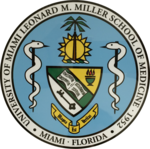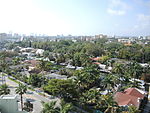Jackson Memorial Hospital (also known as "Jackson" or abbreviated "MJMH") is a non-profit, tertiary care hospital, the primary teaching hospital of the University of Miami's School of Medicine. It is the largest hospital in the United States by number of beds as of 2021 according to Becker's Hospital Review. The hospital is located in Miami's Health District at 1611 NW 12th Avenue at the Northwest quadrant of Interstate 95 and the Dolphin East-West Expressway, two of metropolitan Miami's most heavily trafficked highways. The hospital is accessible by Miami Metrorail's rapid transit system at the Civic Center Station stop at 1501 Northwest 12th Avenue in Miami.
Jackson Memorial Hospital is the center of a thriving medical campus in Miami's Health District that includes Miami's Veterans Administration Medical Center, the University of Miami Hospital (formerly Cedars of Lebanon Medical Center), and the University of Miami's Leonard M. Miller School of Medicine with its vast research affiliates, laboratories, and institutes, including the University of Miami Sylvester Comprehensive Cancer Center, the University of Miami's Bascom Palmer Eye Institute (the nation's top-rated ophthalmology hospital), the Anne Bates Leach Eye Hospital, the Diabetes Research Foundation, the National Parkinson's Foundation, and the University of Miami's Project to Cure Paralysis.
Jackson Memorial Hospital's Miami Transplant Institute is the largest transplant center in the U.S., performing more transplants in 2019 than any U.S. center has ever performed in a single year. It is the only hospital in Florida to perform every kind of organ transplant for both adult and pediatric patients.It is currently the third-largest public hospital and third-largest teaching hospital in the United States. The hospital is a referral center, a magnet for research and home to the Ryder Trauma Center, the only Level 1 adult and pediatric trauma center in Miami-Dade County, the most populous county in Florida and the seventh-most populous county in the nation.Jackson Memorial is the centerpiece of the Jackson Health System, owned and operated by Miami-Dade County through the Public Health Trust. The hospital is supported by Miami-Dade County residents through a half-cent sales tax. In 2014, the Public Health Trust received $364 million in unrestricted funds from Miami-Dade County. In 2013, Miami-Dade voters approved a separate $830 million bond program for major upgrades to the facility.








